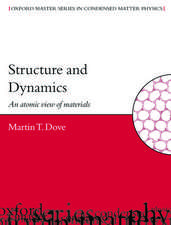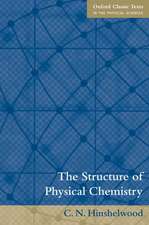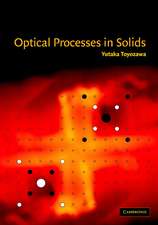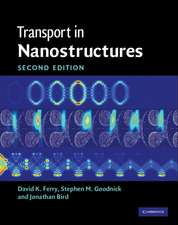Computing in Accelerator Design and Operation: Proceedings of the Europhysics Conference Held at the Hahn-Meitner-Institut für Kernforschung Berlin GmbH Berlin, Germany, September 20–23, 1983: Lecture Notes in Physics, cartea 215
Editat de W. Busse, R. Zelaznyen Limba Engleză Paperback – dec 1984
Din seria Lecture Notes in Physics
- 19%
 Preț: 424.00 lei
Preț: 424.00 lei - 17%
 Preț: 360.73 lei
Preț: 360.73 lei -
 Preț: 429.22 lei
Preț: 429.22 lei - 17%
 Preț: 427.62 lei
Preț: 427.62 lei - 17%
 Preț: 460.26 lei
Preț: 460.26 lei -
 Preț: 427.96 lei
Preț: 427.96 lei -
 Preț: 481.93 lei
Preț: 481.93 lei - 17%
 Preț: 494.66 lei
Preț: 494.66 lei -
 Preț: 281.90 lei
Preț: 281.90 lei - 17%
 Preț: 493.20 lei
Preț: 493.20 lei - 17%
 Preț: 426.72 lei
Preț: 426.72 lei -
 Preț: 365.15 lei
Preț: 365.15 lei -
 Preț: 374.52 lei
Preț: 374.52 lei -
 Preț: 407.98 lei
Preț: 407.98 lei - 20%
 Preț: 428.13 lei
Preț: 428.13 lei -
 Preț: 263.30 lei
Preț: 263.30 lei - 15%
 Preț: 593.73 lei
Preț: 593.73 lei - 15%
 Preț: 528.13 lei
Preț: 528.13 lei -
 Preț: 493.12 lei
Preț: 493.12 lei - 17%
 Preț: 425.68 lei
Preț: 425.68 lei -
 Preț: 280.65 lei
Preț: 280.65 lei -
 Preț: 163.41 lei
Preț: 163.41 lei - 18%
 Preț: 726.59 lei
Preț: 726.59 lei -
 Preț: 394.84 lei
Preț: 394.84 lei - 15%
 Preț: 709.63 lei
Preț: 709.63 lei - 15%
 Preț: 623.90 lei
Preț: 623.90 lei - 20%
 Preț: 476.93 lei
Preț: 476.93 lei - 15%
 Preț: 428.05 lei
Preț: 428.05 lei -
 Preț: 342.78 lei
Preț: 342.78 lei - 18%
 Preț: 851.93 lei
Preț: 851.93 lei -
 Preț: 346.61 lei
Preț: 346.61 lei -
 Preț: 391.57 lei
Preț: 391.57 lei - 15%
 Preț: 633.16 lei
Preț: 633.16 lei -
 Preț: 451.71 lei
Preț: 451.71 lei - 5%
 Preț: 1497.80 lei
Preț: 1497.80 lei -
 Preț: 374.85 lei
Preț: 374.85 lei -
 Preț: 380.07 lei
Preț: 380.07 lei - 15%
 Preț: 516.14 lei
Preț: 516.14 lei - 15%
 Preț: 583.78 lei
Preț: 583.78 lei - 15%
 Preț: 508.60 lei
Preț: 508.60 lei -
 Preț: 469.73 lei
Preț: 469.73 lei -
 Preț: 388.90 lei
Preț: 388.90 lei - 15%
 Preț: 500.24 lei
Preț: 500.24 lei -
 Preț: 386.52 lei
Preț: 386.52 lei - 15%
 Preț: 472.88 lei
Preț: 472.88 lei -
 Preț: 424.27 lei
Preț: 424.27 lei -
 Preț: 380.07 lei
Preț: 380.07 lei - 15%
 Preț: 500.01 lei
Preț: 500.01 lei
Preț: 410.07 lei
Nou
Puncte Express: 615
Preț estimativ în valută:
78.48€ • 85.21$ • 65.92£
78.48€ • 85.21$ • 65.92£
Carte tipărită la comandă
Livrare economică 23 aprilie-07 mai
Preluare comenzi: 021 569.72.76
Specificații
ISBN-13: 9783540139096
ISBN-10: 3540139095
Pagini: 596
Ilustrații: XII, 578 p. 193 illus.
Dimensiuni: 170 x 244 x 31 mm
Greutate: 0.93 kg
Editura: Springer Berlin, Heidelberg
Colecția Springer
Seria Lecture Notes in Physics
Locul publicării:Berlin, Heidelberg, Germany
ISBN-10: 3540139095
Pagini: 596
Ilustrații: XII, 578 p. 193 illus.
Dimensiuni: 170 x 244 x 31 mm
Greutate: 0.93 kg
Editura: Springer Berlin, Heidelberg
Colecția Springer
Seria Lecture Notes in Physics
Locul publicării:Berlin, Heidelberg, Germany
Public țintă
ResearchCuprins
Future high energy accelerators.- Beam optics and dynamics.- Design of r.f. cavities.- Computer aided magnet design.- Beam instabilities and computer simulations.- Calculation of polarization effects.- Particle tracking in accelerators with higher order multipole fields.- Programs for designing the accelerating cavities for linear accelerators.- The MAGMI program for double pass electron linear accelerators.- A fortran program (RELAX3D) to solve the 3 dimensional poisson (Laplace) equation.- Calculation of three dimensional electric fields by successive over-relaxation in the central region of a cyclotron.- The design of the accelerating cavity for SuSe with the aid of the three-dimensional cavity calculation program CAV3D.- The further development of the calculation of the three dimensional electric field in the central region of the INR cyclotron.- Particle tracking using lie algebraic methods.- Numerical investigation of bunch-merging in a heavy-ion-synchrotron.- Nonlinear aspects of Landau damping in computer simulation of the microwave instability.- The transport theory of particle beam-congregation in six-dimensional phase space.- The MAD program.- Analogue computer display of accelerator beam optics.- A Monte Carlo beam transport program, REVMOC.- Multiparticle codes developed at GANIL.- MIRKO — an interactive program for beam lines and synchrotrons.- Aperture studies of the BNL colliding beam accelerator with reduced superperiodicity.- The study of misalignmental characteristics of beam optical components of HI-13 tandem.- Calculations for the design and modification of the 2 cyclotrons of S.A.R.A..- Magnetic field optimization and beam dynamics calculations for SuSe.- ‘DFLKTR’ the code for designing the electrostatic extraction system for cyclotrons.- RFQdesign considerations.- Effects of higher order multipole fields on high current RFQ accelerator design.- Versatile codes and effective method for orbit programming with actually existing first harmonics in cyclotron.- Calculations of the heavy ion saclay tandem post accelerator beams.- Electron injector computer simulations.- Numerical simulations of orbit correction in large electron rings.- Simulation of polarization correction schemes in e+e? storage rings.- Computation of electron spin polarisation in storage rings.- Archsim: A proton synchrotron tracking program including longitudinal space charge.- A method for distinguishing chaotic from quasi-periodic motions in orbit tracking programs.- PATH — a lumped-element beam-transport simulation program with space charge.- Workshop no. 1. Computer programs for lattice calculations.- Digital control of accelerators — the first ten years.- Distributed digital control of accelerators.- Centralized digital control of accelerators.- Concurrent control of interacting accelerators with particle beams of varying format and kind.- Integrated control and data acquisition of experimental facilities.- Software engineering tools.- Centralization and decentralization in the TRIUMF Control System.- The Fermilab Accelerator Controls System.- The control system for the daresbury synchrotron radiation source.- The microprocessor-based control system for the Milan superconducting cyclotron.- The ELSA control system hardware.- Computer control system of polarized ion source and beam transport line at KEK.- Computer control system of TRISTAN.- The system for process control and data analysis based on microcomputer and CAMAC equipment in the LAE 13/9 linear electron accelerator.- Some features of the computer control system for theSpallation Neutron Source (SNS) of the Rutherford Appleton Laboratory.- Design criteria for the operation of accelerators under computer control.- Computer aided control of the bonn penning polarized ion source.- Treatment and display of transient signals in the CERN antiproton accumulator.- Fast CAMAC-based sampling digitizers and digital filters for beam diagnostics and control in the CERN PS complex.- Automated cyclotron magnetic field measurement at the University of Manitoba.- On the problem of magnet ramping.- High level control programs at NSLS.- The minicomputer network for control of the dedicated synchrotron radiation storage ring BESSY.- The electronic interface for control of the dedicated synchrotron radiation storage ring BESSY.- to computing for accelerator operation.- Man-machine interface versus full automation.- Models and simulations.- Operations and communications within the Daresbury nuclear structure facility control system.- Consoles and displays for accelerator operation.- Operator interface to the oric control system.- Computer aided setting up of VICKSI.- GANIL beam setting methods using on-line computer codes.- A multi-processor, multi-task control structure for the CERN SPS.- Computer codes for automatic tuning of the beam transport at the Unilac.- Interactive testprogram for ion optics.- Numerical orbit calculation for a linac and improvement of its transmission efficiency of a beam.- The computerized beam phase measurement system at GANIL its applications to the automatic isochronization in the Separated Sector Cyclotrons (SSC) and other main tuning procedures.- On-line optimization code used at Saturne.- Automatic supervision for Saturne.- A local computer network for the experimental data acquisition at BESSY.- Closing remarks.


















